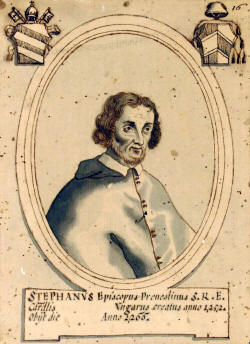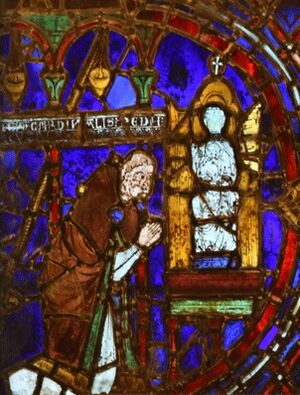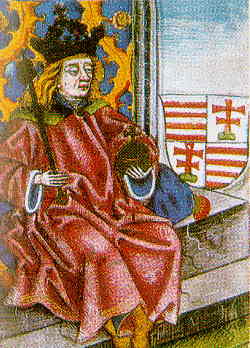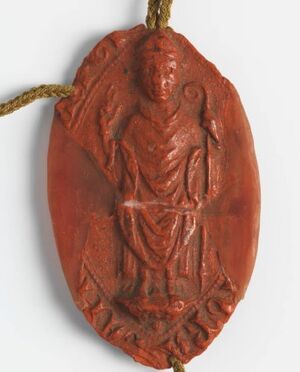Stephen I Báncsa facts for kids
Quick facts for kids His Eminence Stephen Báncsa |
|
|---|---|
| Cardinal Bishop of Palestrina Archbishop of Esztergom |
|

Stephen Báncsa
|
|
| Province | Esztergom |
| See | Esztergom |
| Appointed | 14 August 1242 |
| Enthroned | 7 July 1243 |
| Reign ended | 1252 |
| Predecessor | Matthias Rátót |
| Successor | Benedict II |
| Other posts | Cardinal Bishop of Praeneste |
| Orders | |
| Created Cardinal | December 1251 |
| Rank | Cardinal-Bishop |
| Personal details | |
| Born | c. 1205 |
| Died | 9 July 1270 Rome |
| Buried | Santa Balbina |
| Nationality | Hungarian |
| Denomination | Roman Catholic |
| Previous post |
|
| Coat of arms |  |
Stephen (I) Báncsa (Hungarian: Báncsa (I.) István, Latin: Stephanus de Bancha; died 9 July 1270) was a very important figure in the 13th-century Catholic Church. He was the first Hungarian to become a cardinal. Before this, he served as the Bishop of Vác and then as the Archbishop of Esztergom, which is a major church leader role in Hungary.
Contents
Stephen Báncsa's Family Background
Stephen Báncsa was born around 1205. He came from the Báncsa family, an old family from a region called Bács County. His father was Orbász I, who was a count. Orbász I was buried in the St. Adalbert Cathedral in Esztergom.
Stephen had at least two brothers. His brother Vincent was an important official in Esztergom County. Vincent's son, Stephen II Báncsa, also became a church leader, serving as the Archbishop of Kalocsa. This shows how Stephen Báncsa influenced his family. Another brother, Peter, had a son named Orbász II, who was the first Hungarian to get a doctorate degree from the University of Padua.
Early Career as a Church Official
Stephen Báncsa first appeared in official records in 1238. At that time, he was the Provost of Bács. A provost is a senior church official. He was also the Chancellor for King Béla IV. The chancellor was a key advisor to the king.
In 1239, Stephen moved to Titel, where he also served as provost. He helped solve land disputes for the church. He stopped being chancellor in March 1240.
Becoming a Bishop and Archbishop
Bishop of Vác
Stephen Báncsa became the Bishop of Vác around 1240 or 1241. In 1241, a huge event happened: the Mongol invasion. King Béla IV sent Stephen and two other church leaders to help his wife, Queen Maria Laskarina, escape to Austria. This meant Stephen was not at the Battle of Mohi where many Hungarian leaders were killed.
After the Mongols won, they destroyed many towns, including Vác, Stephen's home diocese. Stephen traveled to Rome to tell Pope Gregory IX about the disaster. He asked for help, but no reinforcements arrived.
Archbishop of Esztergom
While the king was in Dalmatia (modern-day Croatia), Stephen Báncsa was chosen as the Archbishop of Esztergom in 1242. This was a very important position. He still kept his role as Bishop of Vác for a short time.
Pope Innocent IV confirmed Stephen's appointment as Archbishop of Esztergom in July 1243. The Pope also made him a special representative, called an Apostolic Legate, for Croatia and Dalmatia. This meant Stephen had a lot of power and responsibility.
As archbishop, Stephen worked to make the Esztergom Archdiocese stronger. He made sure other church groups, like chapters and monasteries, followed the archbishop's authority. He also helped rebuild areas destroyed by the Mongols. He brought in new settlers, especially Germans, to live in Vác.
Stephen also increased the church's land and wealth. He bought and exchanged properties. He made sure the canons (priests) of the St. Adalbert Cathedral received money from wine production.
Stephen sometimes disagreed with King Béla IV. For example, the king was unhappy when a new bishop was chosen for Veszprém without his approval. Stephen supported the new bishop, showing his independence. Pope Innocent IV trusted Stephen and asked him to help strengthen castles against future Mongol attacks.
Stephen Báncsa also supported new religious groups in Hungary. In 1246, a man named Eusebius asked Stephen for permission to become a hermit. Later, Eusebius founded the only Hungarian monastic order, the Order of Saint Paul the First Hermit. Stephen also protected the rights of the Franciscans, Dominicans, and Knights Hospitaller.
Becoming a Cardinal
The First Hungarian Cardinal

In December 1251, Pope Innocent IV made Stephen Báncsa a Cardinal Bishop of Praeneste (Palestrina). This was a huge honor, as Stephen became the first Hungarian cardinal ever. The Pope wanted to increase the number of cardinals. This was important because many cardinal positions were empty.
Some historians believe Stephen was chosen because of the ongoing threat from the Mongols. He could represent Hungary's needs in Rome. Others think it was part of the Pope's plan to show the Church's worldwide influence. Stephen's good relationship with Pope Innocent IV might also have played a role.
After becoming a cardinal, Stephen remained Archbishop of Esztergom until October 1252. He then moved to Rome. However, he was allowed to continue managing the Esztergom Archdiocese from afar for a while. He even kept some of its income.
Stephen found being a cardinal difficult and expensive. He tried to return to Hungary permanently, but the Pope and other cardinals wanted him to stay in Rome. Eventually, a new archbishop was chosen for Esztergom in 1254, and Stephen had to return to Rome.
Life in the Roman Curia
As a cardinal, Stephen Báncsa had his own household in Orvieto, Italy. This household included many people, both church officials and laymen. Some of them were Hungarians, like his nephews, who he hired a tutor for.
Stephen was active in the Pope's government. He signed many papal documents and advised the Pope. He was present when Pope Innocent IV died in Naples in 1254. Stephen then participated in the election of the next Pope, Pope Alexander IV. He was one of the cardinals who took a neutral stance during the election.
He often served as an "Auditor," which meant he investigated church legal cases. For example, he looked into a case about a bishop accused of simony (selling church positions). He also helped settle disputes between different bishops.
Stephen mostly focused on church laws and internal church matters. He did not get involved much in the big political conflicts between Rome and other kingdoms.

In 1260, Stephen signed a decree about Greek and Latin churches in Cyprus. In 1261, he signed a document helping a convent in Germany. He was also present at the election of Pope Urban IV in 1261.
From 1261 to 1265, Stephen Báncsa might have been the cardinal protector of the Franciscans. This meant he looked after their interests in the Roman Curia. He also worked to help the Poor Clares, the female branch of the Franciscan Order.
Stephen's relationship with the Hungarian king, Béla IV, remained difficult. In 1263, Stephen's nephew was nominated to be a bishop in Hungary. Pope Urban IV asked for Stephen's opinion, and the nomination was refused because his nephew was too young. Stephen suggested his own chamberlain, Timothy, instead. King Béla was very unhappy about this. He felt Timothy was not a good choice and that Stephen was giving church benefits to his relatives.
Stephen was also present for the election of Pope Clement IV in 1265. He continued to work on church matters, like helping a group of hermits called the Williamites. He helped them keep some of their independence.
By 1268, Stephen Báncsa was getting older and slowly retired from public life. He was still in Viterbo, Italy, in the Pope's court. He participated in the very long papal election that started in November 1268.
Stephen Báncsa's Death
Stephen Báncsa became ill in July 1270. He wrote his last will on July 5, 1270, and died four days later, on July 9, 1270. He was buried in the Santa Balbina basilica in Rome. In his will, he gave his church clothes, objects, and books to different churches and people. Two important cardinals, including the future Pope Nicholas III, were in charge of carrying out his will.
Some historical records suggest he might have died in 1271, as he was mentioned in a document from August 1270. However, he did not participate in the final vote of the papal election in September 1271.
In Art
A French art historian once thought that a stained glass window in the Chartres Cathedral in France showed Stephen Báncsa. This window shows scenes from the life of Saint Nicholas. The historian believed Stephen was the "donator" (giver) of the window. However, later research showed that the person in the window is actually Étienne Chardonnel, a canon from Paris.
Sources
|
Stephen I
Genus Báncsa
Born: c. 1205 Died: 9 July 1270 |
||
| Political offices | ||
|---|---|---|
| Preceded by Matthias Rátót |
Chancellor 1238–1240 |
Succeeded by Benedict |
| Catholic Church titles | ||
| Preceded by Matthias Rátót |
Bishop of Vác 1240/1–1243 |
Succeeded by Heimo |
| Archbishop of Esztergom 1242–1252 |
Succeeded by Benedict |
|
| Preceded by Giacomo Pecoraria |
Cardinal-bishop of Palestrina 1251–1270 |
Succeeded by Vicedomino de Vicedominis |



